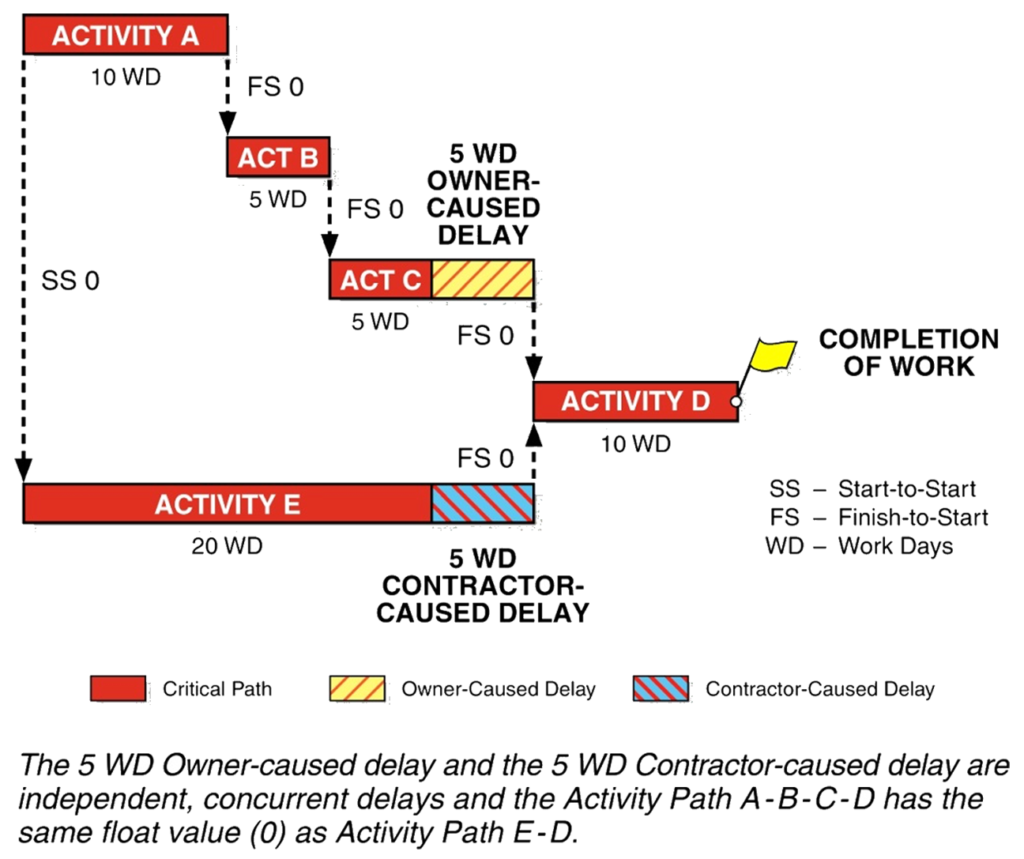
October 28, 2022
Concurrent Delay Defined
This is the first of two blog posts examining concurrent delay, a vexed and complex technical and legal issue. The challenge is to determine equitably: 1) the contractor’s entitlement to a time extension as a result of an owner-responsible delay event (liability) and recovery of the contractor’s extended time-related costs (damages) that result from such delays; and 2) the owner’s recovery of its actual delay or liquidated damages when the contractor fails to complete its work by a contractually stipulated completion date as a result of a contractor-responsible delay event that is concurrent to the owner-responsible delay event.
The generally accepted approach for liability determination as a result of delays that are caused by each party is to determine whether the delay can be apportioned between the parties. If the delay can be allocated among the parties, proportional fault is most commonly used to determine cost recovery. A CPM schedule is used to identify and determine critical path delays and the party responsible for those delays. With a schedule analysis, the delays are segregated along the critical path and allocated to the responsible party. However, this approach is complicated when parties allege that certain of the delays are concurrent.
Construction contracts often do not expressly provide direction as to the parties’ agreement when there is concurrent delay. Most contracts simply require the contractor to provide notice and specifics when an owner-responsible delay event occurs. The owner then must determine the appropriate time extension, if any, to which the contractor is entitled. However, the owner may be reluctant to grant the contractor an extension of time if the contractor caused its own delay during the same period. The owner also must consider its position with respect to its actual or liquidated damages as a result of the contractor-caused delay. A dispute may then occur as to whether the contractor is entitled to any extension of time if it also caused delay in the same period.
The term “concurrent delay” is commonly used to describe circumstances where different causes of delay overlap during a period of time or schedule window. As such, concurrent delay could occur during a window if a delay that the owner caused is on the same activity path or a parallel activity path as a delay that the contractor caused. If the owner-caused delay and contractor-caused delay affect the same activity or affect different activities on parallel activity paths that are critical or near critical, and as such the owner-caused delay and contractor-caused delay would each have delayed the completion date of the project, the delays are said to be concurrent. However, a delay that does not affect the overall project completion is incidental, not compensable, and may not qualify as a concurrent delay. Further, not all delays need to be apportioned to the various parties. For example, if the contractor’s case is that the owner and its engineer both caused a joint error leading to the delay on a project, then the delay need not be apportioned between the owner and the engineer.
For example, as shown in Figure 1, two parallel activity paths are each delayed by five work days during the same window by separate causes. The owner caused one delay, the contractor caused the other delay, and both affected activities have the same float value. The two five‑work day delays are concurrent.
Figure 1
Illustration of Concurrent Delays

This situation is significant when one cause of the delay is at the owner’s risk, while the other, competing cause of delay is at the contractor’s risk, and where both causes may be regarded as having caused or contributed to the delay on the project. The analysis of concurrent delays may have to sort out excusable compensable delays that the owner caused, excusable but non-compensable delays such as force majeure delays, and non-excusable delays that the contractor caused.
A primary tenet of construction contracts is that there is an implied warranty in every contract that neither party can delay or hinder the timely performance of the other party. In the case of concurrent delay, it is argued that both parties have delayed or hindered the timely performance of the contract.
ADDITIONAL RESOURCES

Blog
Discover industry insights on construction disputes and claims, project management, risk analysis, and more.
MORE

Articles
Articles by our engineering and construction claims experts cover topics ranging from acceleration to why claims occur.
MORE

Publications
We are committed to sharing industry knowledge through publication of our books and presentations.
MORE
Recommended Reads
Analysis of Concurrent Delay on Construction Claims
This article addresses treatment of concurrent delay in various legal jurisdictions, allocation of delay responsibility when concurrent delay occurs, pacing vs. concurrent delay, and more.
READ
Construction Claim Types for Contractors
U.S. federal and state courts recognize 19 basic construction claim entitlements for a contractor’s recovery of damages. This post is the first of a series discussing each of these 19 types.
READ
Definitions of Construction Claim Types for Contractors
The author summarizes the definitions of the 19 construction claim types that may apply to a contractor's and subcontractor's recovery of time and costs.
READ

